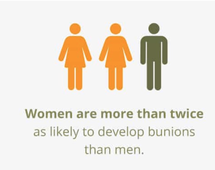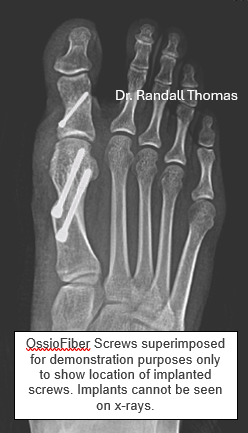MIS: Minimal Invasive Surgery for Bunions
Already know about bunions scroll down to MIS Bunion Surgery information below.
|
What are Bunions?
Bunions are a condition describing a noticeable bump at the great toe. They can occur at any age from birth through adulthood, but are more commonly a problem after the older we get. Did I inherit this from my parent(s)? Yes...and No. You do inherit the type of feet your parent have, however, acquired bunions take time to develop through the years. Shoe gear, trauma, weight gain, and pregnancy are just a few of the additional causes of bunions. How does a bunion form? The formation of a bunion occurs with a capsule, tendon imbalance which can involve the entire foot. The joint looses range of motion and stiffens. Inflammation and the development of arthritis can easily occur and worsen the longer you have the bunion. Over time the metatarsal bone protrudes to the inside and the big toe shifts towards the 2nd toe or over/under laps the second toe. . How do shoes affect bunions? The true cause of a bunion is abnormal mechanics of the toe joint. Shoes may accelerate or worsen the formation of the bunion and lead to more pain. If the bump rubs on the shoe there can be pressure on the nerve under the skin leading to sharp pain and inflammation of the area. This explains why wearing wider, larger or more accommodating shoes helps to relieve the pain of bunions. Deciding to Treat Your Bunion? Many factors to consider including but not limited to: level of pain, cosmetic appearance, big toe joint damage, gait changes and other pain such as knee hip or back, emotional concerns, can’t fit in your shoes.
|
Fun Facts from UFAI
|
Should You Treat a Bunion Conservatively or Surgically?
Depends! The following are some items to consider in making this important decision.
- Wear wider shoes or better fitting shoes. Have you shoe modified to accommodate your bunion?
- Place a pad over the prominent bump.
- Decrease your level of activity.
- Get prescription orthotics (inserts) to return the joint back to normal function.
- Take pain medications (prescription or over-the-counter).
- Have the joint injected with cortisone if extremely inflamed and painful.
- Do nothing about it.
If the above measures don't help you then,
Consider having the bunion surgically corrected.
Have you been avoiding bunion surgery because your only option is the traditional surgery with significant pain and being off your foot and work for up to 3 months? If so see Dr. Thomas to see if you’re a candidate for MIS bunion surgery.
Depends! The following are some items to consider in making this important decision.
- Wear wider shoes or better fitting shoes. Have you shoe modified to accommodate your bunion?
- Place a pad over the prominent bump.
- Decrease your level of activity.
- Get prescription orthotics (inserts) to return the joint back to normal function.
- Take pain medications (prescription or over-the-counter).
- Have the joint injected with cortisone if extremely inflamed and painful.
- Do nothing about it.
If the above measures don't help you then,
Consider having the bunion surgically corrected.
Have you been avoiding bunion surgery because your only option is the traditional surgery with significant pain and being off your foot and work for up to 3 months? If so see Dr. Thomas to see if you’re a candidate for MIS bunion surgery.
Non Surgical Bunion Treatment
|
Non Surgical Bunion Treatments are not designed to fix the deformity and are meant simply to provide symptom relief or slow the progression of the deformity. These options include:
- Prefabricated or Custom Orthotics - Splints and Toe Bracing - Padding and Shoe Modifications - Physical Therapy and Home Exercises - Anti Inflammatory Oral and Topical Medications - Injections into the Big Toe Joint (including corticosteroid, PRP, etc...) - MLS Cold Laser Therapy (anti- inflammatory) - Wider Shoes or Orthopedic Shoes |
What about laser or chiropractics manipulation?
Technology is constantly advancing. However, don't be fooled! Laser cannot be used to reduce a bunion because bone is involved in the process of correcting a bunion. Current laser technology is not capable of cutting bone without damage to the bone itself. A bunion can be temporarily reduced by manipulation but only corrected by cutting and moving bone. Save your money and time. There are MLS cold laser options approved by FDA for joint inflammation which can relieve bunion pain but is only temporarily and cannot correct the deformity.
As a patient contemplating bunion surgery you are no given the task of the selecting the right surgeon.
Bunion surgery is considered highly successful and proven for the reduction of pain and disfigurement. Thus many insurance companies cover this procedure.
NOT ALL SURGEONS USE THE SAME TECHNIQUES OR HAVE THE SAME LEVEL OF TRAINING AND EXPERIENCE
Technology is constantly advancing. However, don't be fooled! Laser cannot be used to reduce a bunion because bone is involved in the process of correcting a bunion. Current laser technology is not capable of cutting bone without damage to the bone itself. A bunion can be temporarily reduced by manipulation but only corrected by cutting and moving bone. Save your money and time. There are MLS cold laser options approved by FDA for joint inflammation which can relieve bunion pain but is only temporarily and cannot correct the deformity.
As a patient contemplating bunion surgery you are no given the task of the selecting the right surgeon.
Bunion surgery is considered highly successful and proven for the reduction of pain and disfigurement. Thus many insurance companies cover this procedure.
NOT ALL SURGEONS USE THE SAME TECHNIQUES OR HAVE THE SAME LEVEL OF TRAINING AND EXPERIENCE
How to pick a Bunion Surgeon
Corrective bunion surgery is not a one size fits all procedure. The human foot is a complex mechanism supported by 26 bones, 33 joints, and over 100 unique muscles, tendons and ligaments. Estimated more than 150,000 bunion procedures done annually in the United States, unfortunately many of these are revisional surgeries. Dr. Thomas performs many revisional surgeries sent to him from other providers.
Although a bunion looks like a localized problem, it involves the entire foot, ankle, and calf. Choosing the wrong bunion surgeon could set you up for future pain, arthritis, and a recurring bunion. Fortunately, there many high-quality bunion surgeons who can provide individualized treatment for the best possible surgical outcome. If you’re not a candidate for MIS bunion surgery Dr. Thomas will advise the correct procedure for you. How do you find a good bunion surgeon? Consider these tips while doing your research.
Note: If you meet a doctor that performs just one type of bunion surgery, you might want to look elsewhere.
Where to Start
The internet is a great resource that enables you to obtain a lot of information quickly. However you can’t always trust websites and physician reviews online. The hospital websites are a good source for which doctors are credentialed or not.
Ask your social network. You might be surprised by how many of your friends, family members, and coworkers have had foot surgery.
Call your local surgery center or hospital and ask for their foot and ankle surgeons on staff.
You could also get a recommendation from your primary care physician. Depending on your insurance coverage, you may not be able to see certain specialists without your doctor’s referral. You will want to check with your insurance carrier.
Make sure you only seek out board-certified surgeons. A surgeon certified by the American Board of Foot and Ankle Surgery has been recognized for his or her expertise in the field. An orthopedic surgeon may be certified by the American Board of Orthopedic Surgery but recommend they are affiliated with the AOFAS (American Orthopedic Foot & Ankle Society) as they're typically focused mostly on the foot and Ankle. .
Your bunion surgeon should be taking these factors into consideration before presenting you with a surgical plan.
Questions for a Bunion Surgeon
How many bunion surgeries, and what types, have you performed?You will want your bunion surgeon to have plenty of experience, as well as expertise on various bunion surgery techniques. If your surgeon uses the same procedure for all patients, he or she is not going to provide you with the individualized attention that your unique condition needs. There are still bunion surgeons who only do a small amount of these procedures a year.
How often do your patients need a revision of your work?A bunion surgery might fail for several reasons. The bunion may be under- or over-corrected. A failed surgery may result in complications such as delayed bone union, malunion, or nonunion, a trapped nerve, stiffness in the joint, or excessive shortening of the first metatarsal. Or, the bunion may return, having never been truly corrected in the first place. Or the patient may not follow the set post op protocol and end up with a poor result.
Will you be using hardware, like screws or plates?Surgical hardware can give the foot more stability, greater bone fixation, and generally patients can walk sooner in their recovery. Many older surgeons who have not been trained in new techniques will not use screws or plates to correct bunions and simply “shave off the bump” which always worsens and leads to more stiffness in the joint long term.
Will other areas of my foot be addressed in the surgery?Bunions have structural causes which must be addressed in surgery, or else the bunion will return. Make sure your surgeon takes a whole-foot approach.
Other Considerations
Don’t get discouraged by a busy practice. A busy surgeon is one who has a great reputation and is highly sought-after. Dr. Thomas at times can have longer than average waits but patients report outcomes are more important than wait times. Also if you’re surgeon is truly doing these cases they’re likely highly qualified and taking Hospital call for foot & Ankle Surgery and the office day commonly gets disrupted by this issue for emergencies at the hospital.
Does your surgeon and their staff provide courteous and compassionate care? You should feel good about working with this practice over the long run. Communication should be good and the surgeon available at all times. If the surgeons bedside manner is poor pre operatively it won’t be any better post operatively.
Try to ignore patient complaints about cost: a good surgical outcome is an investment in your future free of pain. Instead, focus on the surgeons whose patients are happy with their outcomes. Don’t be afraid to travel if able. Commonly the best surgeons often live in larger cities, and are happy to work with out-of-towners. Larger city hospitals require more difficult certification and maintenance of surgical privileges and typically attract the best surgeons. Dr. Thomas has operated on patients from many states throughout the USA as far as Alaska!
Don’t rely entirely on advertising and for websites with physician reviews. Did you know there is a growing problem with review sites not being completed by patients but by competing doctors and other people in the community who’ve never seen the doctor they’re writing about. There is no way to prevent this issue. Additionally word of mouth should be the best advertisement, rely on others you know and trust for their recommendations.
How soon can I walk after bunion surgery?
If you’re a candidate for Dr. Thomas’ MIS Bunion Surgery you will walk the day of the surgery. Major improvement in quality of life and post op recovery being able to ambulated and work on range of motion this quickly after surgery.
Corrective bunion surgery is not a one size fits all procedure. The human foot is a complex mechanism supported by 26 bones, 33 joints, and over 100 unique muscles, tendons and ligaments. Estimated more than 150,000 bunion procedures done annually in the United States, unfortunately many of these are revisional surgeries. Dr. Thomas performs many revisional surgeries sent to him from other providers.
Although a bunion looks like a localized problem, it involves the entire foot, ankle, and calf. Choosing the wrong bunion surgeon could set you up for future pain, arthritis, and a recurring bunion. Fortunately, there many high-quality bunion surgeons who can provide individualized treatment for the best possible surgical outcome. If you’re not a candidate for MIS bunion surgery Dr. Thomas will advise the correct procedure for you. How do you find a good bunion surgeon? Consider these tips while doing your research.
Note: If you meet a doctor that performs just one type of bunion surgery, you might want to look elsewhere.
Where to Start
The internet is a great resource that enables you to obtain a lot of information quickly. However you can’t always trust websites and physician reviews online. The hospital websites are a good source for which doctors are credentialed or not.
Ask your social network. You might be surprised by how many of your friends, family members, and coworkers have had foot surgery.
Call your local surgery center or hospital and ask for their foot and ankle surgeons on staff.
You could also get a recommendation from your primary care physician. Depending on your insurance coverage, you may not be able to see certain specialists without your doctor’s referral. You will want to check with your insurance carrier.
Make sure you only seek out board-certified surgeons. A surgeon certified by the American Board of Foot and Ankle Surgery has been recognized for his or her expertise in the field. An orthopedic surgeon may be certified by the American Board of Orthopedic Surgery but recommend they are affiliated with the AOFAS (American Orthopedic Foot & Ankle Society) as they're typically focused mostly on the foot and Ankle. .
Your bunion surgeon should be taking these factors into consideration before presenting you with a surgical plan.
- How severe is your bunion?
- Do bunions run in your family?
- What type of shoes do you wear, and what type of work do you do?
- What is the shape of your feet? Do you have flat feet or high arches?
- Do you have any other pain or abnormalities? Severe bunions often lead to big toe arthritis, which can be addressed at the time of your surgery if your surgeon is well trained.
- How loose is the first metatarsal? Bunions form when the metatarsal loosens and shifts out of alignment at its base. Your surgeon will need to stabilize it to prevent the bunion from coming back.
- Is the big toe misaligned as well? In some cases, the toe needs to be straightened for the bunion to be corrected.
Questions for a Bunion Surgeon
How many bunion surgeries, and what types, have you performed?You will want your bunion surgeon to have plenty of experience, as well as expertise on various bunion surgery techniques. If your surgeon uses the same procedure for all patients, he or she is not going to provide you with the individualized attention that your unique condition needs. There are still bunion surgeons who only do a small amount of these procedures a year.
How often do your patients need a revision of your work?A bunion surgery might fail for several reasons. The bunion may be under- or over-corrected. A failed surgery may result in complications such as delayed bone union, malunion, or nonunion, a trapped nerve, stiffness in the joint, or excessive shortening of the first metatarsal. Or, the bunion may return, having never been truly corrected in the first place. Or the patient may not follow the set post op protocol and end up with a poor result.
Will you be using hardware, like screws or plates?Surgical hardware can give the foot more stability, greater bone fixation, and generally patients can walk sooner in their recovery. Many older surgeons who have not been trained in new techniques will not use screws or plates to correct bunions and simply “shave off the bump” which always worsens and leads to more stiffness in the joint long term.
Will other areas of my foot be addressed in the surgery?Bunions have structural causes which must be addressed in surgery, or else the bunion will return. Make sure your surgeon takes a whole-foot approach.
Other Considerations
Don’t get discouraged by a busy practice. A busy surgeon is one who has a great reputation and is highly sought-after. Dr. Thomas at times can have longer than average waits but patients report outcomes are more important than wait times. Also if you’re surgeon is truly doing these cases they’re likely highly qualified and taking Hospital call for foot & Ankle Surgery and the office day commonly gets disrupted by this issue for emergencies at the hospital.
Does your surgeon and their staff provide courteous and compassionate care? You should feel good about working with this practice over the long run. Communication should be good and the surgeon available at all times. If the surgeons bedside manner is poor pre operatively it won’t be any better post operatively.
Try to ignore patient complaints about cost: a good surgical outcome is an investment in your future free of pain. Instead, focus on the surgeons whose patients are happy with their outcomes. Don’t be afraid to travel if able. Commonly the best surgeons often live in larger cities, and are happy to work with out-of-towners. Larger city hospitals require more difficult certification and maintenance of surgical privileges and typically attract the best surgeons. Dr. Thomas has operated on patients from many states throughout the USA as far as Alaska!
Don’t rely entirely on advertising and for websites with physician reviews. Did you know there is a growing problem with review sites not being completed by patients but by competing doctors and other people in the community who’ve never seen the doctor they’re writing about. There is no way to prevent this issue. Additionally word of mouth should be the best advertisement, rely on others you know and trust for their recommendations.
How soon can I walk after bunion surgery?
If you’re a candidate for Dr. Thomas’ MIS Bunion Surgery you will walk the day of the surgery. Major improvement in quality of life and post op recovery being able to ambulated and work on range of motion this quickly after surgery.
Minimally Invasive Surgery (MIS) Bunion Procedure
Did you know Dr. Thomas has worked to develop the minimally invasive bunion surgery for over 8 years? He has traveled to numerous states to operate and do cadaver labs and even Europe to further this technique. Great to bring this surgery option to Ohio.
|
Minimal injury and pain:
Is a surgical technique done under minimal injury and steps are taken to ensure the post-operative pain is minimized. The majority of Dr. Thomas’ patients stop taking oral opioids within 48-72 hours after surgery and some simply take OTC Tylenol or Ibuprofen. |
History of MIS Bunion Surgery |
Technique Guide Paper from American Orthopaedic Foot & Ankle Society
|
Can Dr. Thomas perform a bunion surgery without metallic implants?
Yes, thanks to OssioFiberTM implants. Reasons to use biointegrative screws and implants: - Patient does not want implantable hardware long-term as the Ossio Fiber products absorb into bone and give stability. - Patient has an allergy to metals such as Nickel or had hardware complications in previous surgeries *this has been revolutionary for Dr. Thomas' patients. - Almost eliminates risk for return to surgery for hardware removal. |
Dr. Thomas inserting a biointegrative screw in 2021
|
See below bointegrative diagram and x-rays from Dr. Thomas
|
Pre Op Right Foot Bunion
Painful and difficult to fit in shoes. Patient unable to do activities of daily living without pain. |
Not Actual X-ray
OssioFiber Screws superimposed for demonstration purposes only to show location of implanted screws. Implants cannot be seen on x-rays, only the shadow of the screws track. |
Post Op Right Foot Bunion Resolved
OssioFiber Screws are biointegrative meaning they grow into bone as bone cuts heal. |
Post Operative MIS Bunion Surgery
|
Post Operative MIS Bunion Surgery
- Minimal dressing - Ambulation in post op shoe - RICE (rest, ice, compression, elevation) - Antibiotics (pevent infection), DVT (blood clot) prevention medication, pain control - Follow up appointments and early return to activity, work. Post Op Instructions
| |||














